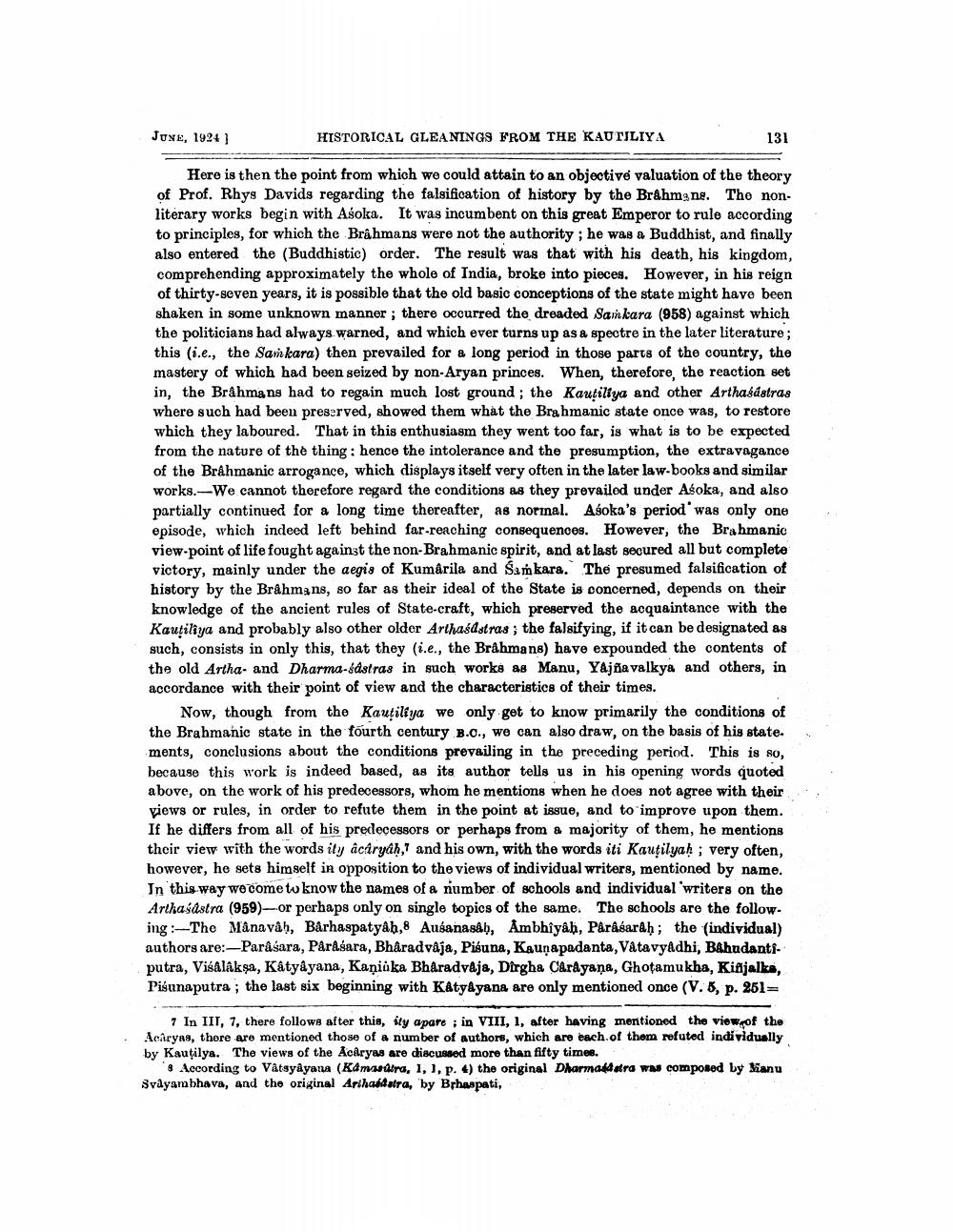________________
JUNE, 1924]
HISTORICAL GLEANINGS FROM THE KAU TULIYA
131
Here is then the point from which we could attain to an objective valuation of the theory of Prof. Rhys Davids regarding the falsification of history by the Brahmone. The nonliterary works begin with Asoka. It was incumbent on this great Emperor to rule according to principles, for which the Brahmans were not the authority; he was a Buddhist, and finally also entered the (Buddhistic) order. The result was that with his death, his kingdom, comprehending approximately the whole of India, broke into pieces. However, in his reign of thirty-seven years, it is possible that the old basic conceptions of the state might have been shaken in some unknown manner; there occurred the dreaded Sankara (958) against which the politicians had always warned, and which ever turns up as a spectre in the later literature; this (i.e., the Sankara) then prevailed for a long period in those parts of the country, the mastery of which had been seized by non-Aryan princes. When, therefore, the reaction set in, the Brahmans had to regain much lost ground; the Kautiliya and other Arthasástras where such had been preserved, showed them what the Brahmanic state once was, to restore which they laboured. That in this enthusiasm they went too far, is what is to be expected from the nature of the thing: hence the intolerance and the presumption, the extravagance of the Brahmanic arrogance, which displays itself very often in the later law-books and similar works.-We cannot therefore regard the conditions as they prevailed under Asoka, and also partially continued for a long time thereafter, as norinal. Asoka's period' was only one episode, which indeed left behind far-reaching consequences. However, the Brahmanic view.point of life fought against the non-Brahmanic spirit, and at last secured all but complete victory, mainly under the aegis of Kumârila and Samkara. The presumed falsification of history by the Brahmans, so far as their ideal of the State is concerned, depends on their knowledge of the ancient rules of State-craft, which preserved the acquaintance with the Kautilya and probably also other older Arthaśdstras ; the falsifying, if it can be designated as such, consists in only this, that they (i.e., the Brahmans) have expounded the contents of the old Artha and Dharma-sdstras in such works as Manu, Yajna valkya and others, in accordance with their point of view and the characteristics of their times.
Now, though from the Kauçiliya we only get to know primarily the conditions of the Brahmanic state in the fourth century B.O., we can also draw, on the basis of his state. ments, conclusions about the conditions prevailing in the preceding period. This is so, because this work is indeed based, as its author tells us in his opening words quoted above, on the work of his predecessors, whom he mentions when he does not agree with their views or rules, in order to refute them in the point at issue, and to improve upon them. If he differs from all of his predecessors or perhaps from & majority of them, he mentions their view with the words ity acaryah, and his own, with the words iti Kautilyah ; very often, however, he sets himself in opposition to the views of individual writers, mentioned by name. In this way we come to know the names of a number of schools and individual writers on the Arthasastra (959)-or perhaps only on single topics of the same. The schools are the following:- The Mâna våh, Barhaspatyah,8 Ausanasah, Ambhiyah, Påråsardh; the (individual) authors are:-Parasara, Parasara, Bharadvája, Pisuna, Kaunapadanta, VatavyAdhi, Bahudantiputra, Visalâksa, Katyayana, Kaniūka Bharadvája, Dirgha Carayana, Ghotamukha, Kifjalka. Pisunaputra ; the last six beginning with Katyayana are only mentioned once (V.8, p. 251=
7 In IIT, 7, there follows after this, ily apare ; in VIII, 1, after having mentioned the view of the Acaryas, there are mentioned those of a number of authors, which are each of them refuted individually by Kautilya. The views of the AcAryas are discussed more than fifty times.
's According to Vatsyâyana (Kamasutra, 1, 1, p. 4) the original Dharmaldatra was composed by Jianu Svayambhava, and the original Arihaldara, by Brhaspati,




